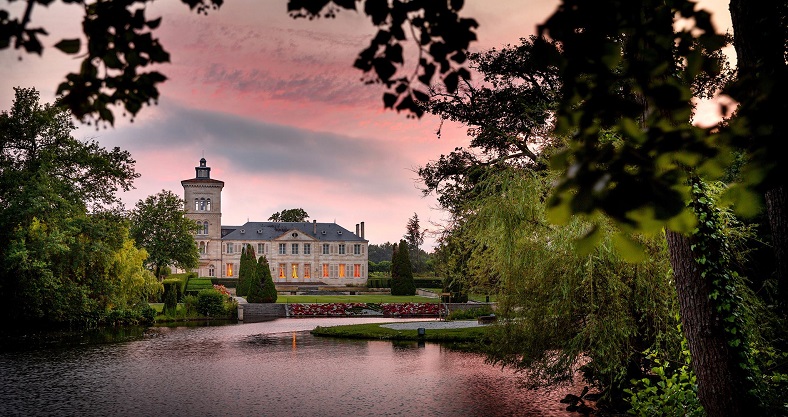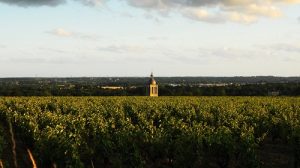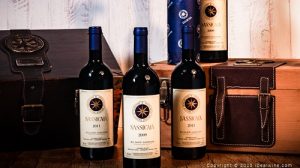
Château Lagrange is a great château in more ways than one. In its size, to begin with, since it covers 118 hectares of the Saint-Julien appellation’s 908; in its history, which can be traced all the way back to Medieval times; and in its rank, as it was labelled a Third Growth in the famous 1855 classification.
Deep roots
The grounds of Lagrange are mentioned as far back as the Middle Ages, during which vine cultivation was already in motion, even if the estate’s land was divided in two at the time by the stream that passes through. Lagrange de Monteil is the house that eventually gave its name to the whole estate when the two halves were brought together in the 17th century. Owned by the Brannes de Cours family for two centuries, they oversaw the modernisation of the vineyard, the fermenting room, and the methods used there. In 1790, the domain was sold to Jean Valère Cabarrus who came from a family of traders and has a Tuscan-inspired tower built at the château by Visconti.
Clearly on a roll and undoubtedly well-established, the château came into its own in the 19th century, owned between 1842 and 1875 by Count Dûchatel, Louis Philippe’s Interior Minister. Duchâtel was an ambitious type, expanding the domain to 280 hectares, 120 of which were used to cultivate vines. He also introduced sulphur to combat the threat of oidium and had pottery pipes installed to drain the soils. It was under Duchâtel’s direction that Lagrange came to be classed as a Third Growth in 1855. After his death, though, the estate’s prestige faded somewhat and some of its plots were sold to neighbouring wine growers. Just 56 hectares remained when the beer and spirits giant Suntory took over in 1983, undertaking huge works to return the domain to its former splendour. This involved repurchasing plots, planting new ones, studying the soil, renovating the winery, and buying new equipment. This strategy has turned out to be a winning one, allowing Château Lagrange to reach its prestigious rank once more and produce wines reputed for their elegance and structure. It is now managed by Matthieu Bordes and Rakusa Sakurai.
Cabernet Sauvignon is King
Today, the vineland stretches across 118 hectares of the Saint-Julien appellation, on two gravelly knolls facing both north and south. The aforementioned soil studies revealed 17 different types of terroir, mainly rich in quartz and gravel over a clay-lime sub-oil. Cabernet Sauvignon is the reigning grape variety here, making up 67% of the vines planted, followed by Merlot and a bit of Petit Verdot. Eleven hectares are used to grow white varietals like Sauvignon Blanc, Sauvignon Gris, and Sémillon. Shared across 103 plots, the vines have an average age of around forty years. For several years now, the estate has been putting more emphasis on respecting the soil and increasing biodiversity in the vineyard, deciding to abandon herbicides and allow grass to grow on certain parcels. Since 2008, ten hectares have been cultivated biodynamically, and twenty organically, without the estate seeking official certification for now.
A single-parcel approach
Precision and quality are the key words employed in the cellar. The hand-harvested grapes are first sorted by hand and then for a second time with the help of an optical camera, allowing for a meticulous selection before pressing. Each parcel is vinified separately in either its own oak cask or stainless-steel container, to preserve the character of each terroir. 102 different containers varying in size from 36 to 220 hectolitres are needed to complete this Herculean task. Fermentation takes between 18 and 25 days, with a session of pumping-up or stirring every day. Oenology consultant Eric Boissenot, alongside four of the estate’s oenologists, craft the blends during the winter that follows each harvest. The wines then continue to mature in French oak casks for around twenty months. Before bottling, fining is carried out using egg whites, ensuring perfect limpidity in the resulting wine.
Power and elegance come together
In line with Bordeaux tradition, the château crafts a fine wine, Château Lagrange, and a second wine, which is called Les Fiefs de Lagrange. Younger vines tend to be used to make the latter. Harmonious and silky, they are mainly characterised by the finesse of their aromas and their powerful structure. The eleven hectares of white grapes are harvested to craft Arums de Lagrange, a fresh and energetic cuvée that’s vinified in casks. Finally, thirteen hectares of vines located in Cussac-Fort-Médoc and Saint-Laurent-du-Médoc, in the Haut-Médoc appellation, produce the Pagus de Lagrange cuvée. This one is a blend of Cabernet Sauvignon and Merlot with a supple and refined character.



